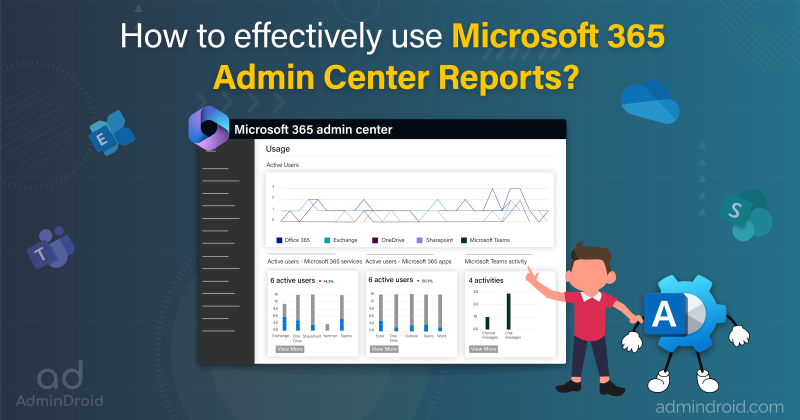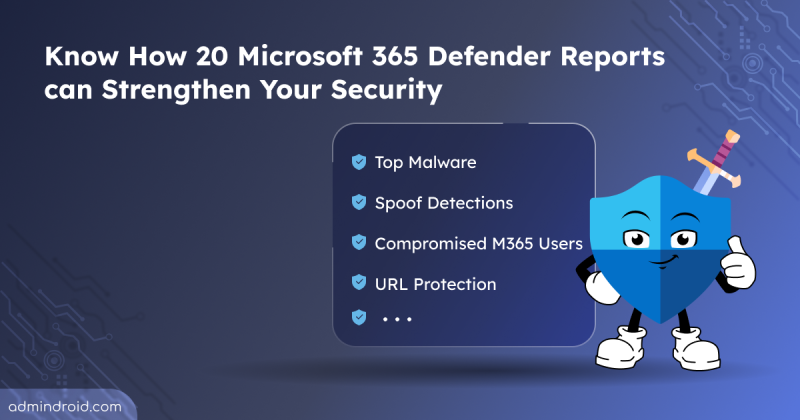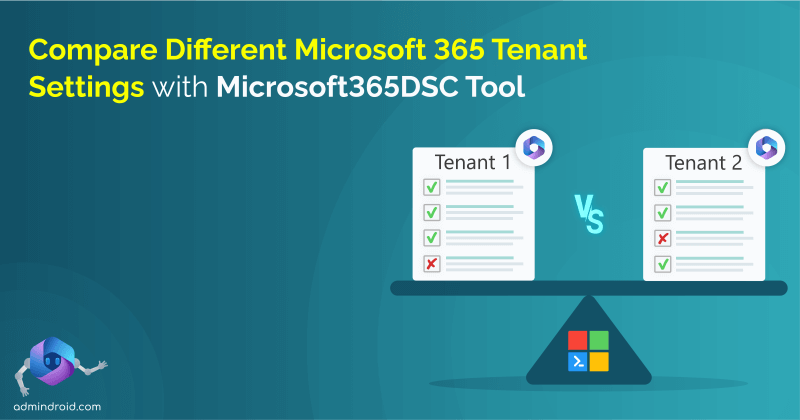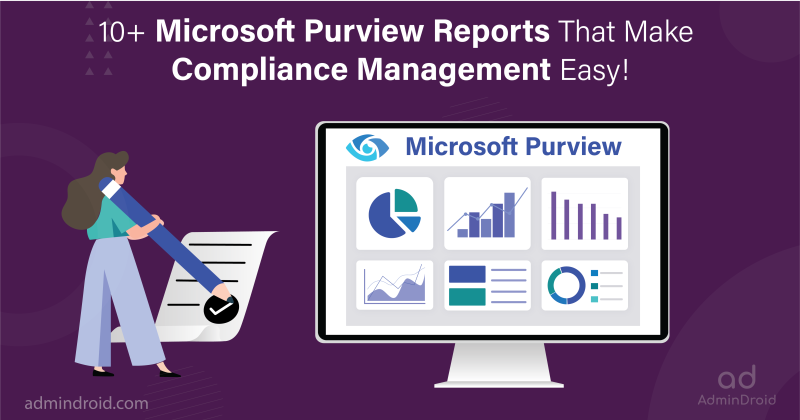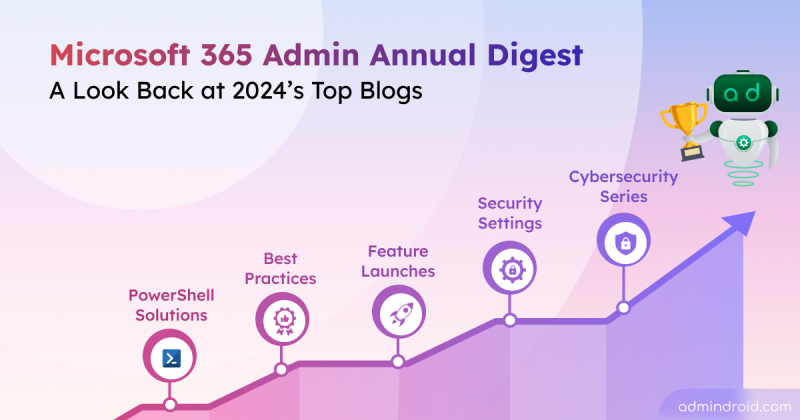On Day 30 of Cybersecurity Awareness Month, explore the best practices to protect Microsoft 365 admin accounts. Discover more valuable security insights packed into our Microsoft 365 Cybersecurity blog series!
As an admin, you’re not just managing Microsoft 365-you’re safeguarding the critical data within it. But with this level of access comes significant responsibility and risks, putting you in the spotlight as a prime target for potential cyberattacks.
Recent attacks like Midnight Blizzard, which targeted critical infrastructure and admin accounts, are strong reminders of the constant threats admins face. This underscores the need for a checklist to confirm that all security measures are properly implemented for admin accounts.
In recognition of National Checklist Day, a thorough checklist is here to help secure Microsoft 365 admin accounts and protect them against threats like Midnight Blizzard. 🛡️ Let’s dive in and explore what the checklist has to offer!
15 Essential Security Practices to Protect Microsoft 365 Admin Accounts
Curious about the best ways to secure your admin accounts? Check out this list of 15 essential practices to protect your Microsoft 365 admin accounts.
- Enable multi-factor authentication for Microsoft 365 admin roles
- Create break glass accounts in Microsoft 365 for emergency
- Require passwordless authentication for admin accounts
- Strengthen admin access control with PIM
- Protect admin accounts with zero trust identity
- Secure admin devices with conditional access policies
- Apply least privilege access to avoid privilege misuse
- Strengthen admin security with cloud-only accounts
- Make use of built-in roles when assigning admin permissions
- Utilize privileged access workstations (PAWs) for admins
- Disable SSPR to protect admin accounts from unauthorized access
- Tighten Microsoft 365 admin security with SIEM
- Safeguard your admin sessions in Microsoft 365
- Create a dedicated user account for everyday tasks
- Securely license admin accounts without service attachments
1. Enable Multi-factor Authentication for Microsoft 365 Admin Roles
✅ License Requirement: Microsoft Entra ID Premium P2
What if your admin credentials fall victim to phishing or brute-force attacks? The consequences could be unimaginable, as attackers with admin privileges can cause significant damages. That’s why configuring multi-factor authentication for admin accounts is essential. MFA adds an extra verification step, such as an authentication app, text message, or biometrics, effectively blocking unauthorized users before access is granted. Make sure to enable MFA for all Microsoft 365 admin accounts to strengthen security.
Additionally, it is one of the key Microsoft Secure Score recommendations, further highlighting its importance for protecting your organization.
2. Create Break Glass Accounts in Microsoft 365 for Emergency
In the event of an MFA outage, you risk getting locked out of your Microsoft 365 tenant. To safeguard against this, it’s crucial to establish backup accounts—known as break glass accounts—that bypass multi-factor authentication. These emergency admin accounts come in handy if the second form of authentication becomes inaccessible, such as when a phone is lost or unavailable. When considering all recovery scenarios, setting up a break glass access app is also helpful if signing in to emergency accounts isn’t possible.
Stay prepared by adhering to best practices for break glass accounts, like setting complex passwords and enabling a fallback domain, to ensure you’re never locked out of your Microsoft 365 tenant.
3. Require Passwordless Authentication for Admin Accounts
✅ License Requirement: Registration and passwordless sign-ins with Microsoft Entra don’t require a license, but a Microsoft Entra ID P1 license is recommended for full passwordless deployment features.
To combat the rising threat of credential theft and compromised accounts, Microsoft advocates for the adoption of passwordless authentication methods. By implementing options like Windows Hello, authenticator app, or passkeys (FIDO2), you can significantly enhance security. Configuring passwordless authentication for Microsoft 365 admin accounts is a proactive step towards safeguarding your organization against malicious attacks. Make the switch today for an added layer of protection!
4. Strengthen Admin Access Control with PIM
✅ License Requirement: To deploy Privileged Identity Management (PIM), a license for either Microsoft Entra ID P2, Microsoft Entra ID Governance, or Microsoft Entra Suite is required.
If a Microsoft 365 user needs temporary admin rights to perform tasks like managing system updates or troubleshooting, granting admin access can pose security risks. Instead, use Privileged Identity Management to offer just-in-time admin access for the specific task. PIM ensures user’s access is automatically revoked after a set period. It also allows you to deploy access reviews to monitor and investigate before granting admin privileges.
Additionally, implement PIM for admin groups rather than configuring individually to streamline permissions, minimize unauthorized access, and reduce privilege misuse.
5. Protect Admin Accounts with Zero Trust Identity
✅ License Requirement: Microsoft 365 E3 or E5
Zero Trust Identity is a security framework that assumes no user or device should be trusted by default. By verifying every access attempt, it adds a critical layer of defense for admin accounts, making it harder for attackers to exploit vulnerabilities.
Implementing Zero Trust Identity strengthens security by continuously authenticating and authorizing access, ensuring that only verified users can interact with sensitive admin functions. Adopting this approach is an essential measure to safeguard Microsoft 365 admin accounts from unauthorized access and potential breaches.
6. Secure Admin Devices with Conditional Access Policies
✅ License Requirement: Microsoft Entra Premium P1 license
Implementing Conditional Access (CA) policies is crucial for protecting admin account devices in Microsoft 365, ensuring secure and compliant device access. These device-based Conditional Access policies ensure that only compliant and trusted devices can access sensitive resources.
Device-based Conditional Access policies require devices to meet specific security configurations before granting access, preventing unauthorized exploitation. This approach enhances security by allowing admin accounts to be accessed only through secure devices, protecting organizational data.
7. Apply Least Privilege Access for Enhanced Microsoft 365 Security
While external threats often making headlines, insider threats can pose even greater risks, leading to significant disruptions and potential damage. A major contributor to these threats is improper access control, as excessive access rights expose organizations to serious vulnerabilities. That’s why adhering to the principle of least privilege access is essential.
By limiting permissions, you can reduce the risk of unauthorized access to sensitive information and prevent privilege escalation attacks. Regularly review and adjust access rights to ensure that users in admin roles retain only the minimum level of access required. This practice safeguards your organization from potential security breaches.
8. Strengthening Admin Security with Cloud-only Accounts
Adopting cloud-only accounts in Microsoft 365 significantly enhances admin security by managing identities solely within Entra ID. This approach eliminates vulnerabilities linked to on-premises infrastructure and allows organizations to implement robust security measures like MFA and Conditional Access policies. By focusing on cloud-based security controls, organizations can effectively reduce the risk of unauthorized access. This approach simplifies administration and strengthens the protection of sensitive admin functions.
If your organization operates in a hybrid environment, it’s recommended to maintain separate admin accounts for managing on-premises resources. This minimizes the attack surface and ensures clear separation of privileges. You can learn more about these best practices in our detailed guide on securing admin accounts in hybrid environments.
9. Make Use of Built-in Roles When Assigning Admin Permissions
✅ License Requirement: Microsoft Entra ID P1 or P2 licenses
Assigning permissions from scratch for every user can be burdensome and increase the risk of granting excessive access. To address this, assign roles to Microsoft 365 users based on their specific tasks. This approach enhances security by ensuring that users receive only the necessary permissions for their tasks, thereby avoiding potential security gaps. Leveraging these Microsoft Entra built-in roles streamlines the permission assignment process while maintaining a secure environment.
10. Utilize Privileged Access Workstations (PAWs) for Admins
✅ License Requirement: Microsoft 365 Enterprise E5 or an equivalent product
Privileged Access Workstations (PAWs) are actually dedicated computers designed to enhance security for admins by isolating administrative tasks from general usage like browsing or email. By using PAWs, admins reduce the risk of malware and phishing attacks targeting standard user environments.
For example, a Privileged Access Workstation allows admins to manage sensitive Microsoft 365 configurations within a secure, isolated environment, reducing credential theft risk. By limiting admin tasks to high-security workstations, PAWs serve as a critical safeguard against potential ransomware attacks targeting admin credentials. This proactive approach enhances data security and strengthens protection against threats aimed at administrative access.
11. Disable SSPR to Protect Admin Accounts from Unauthorized Access
Administrators in sensitive roles should rely solely on phishing-resistant authentication methods, which eliminate the need for Self-Service Password Reset (SSPR). Authentication methods like Passkeys and Temporary Access Pass (TAP), which do not support SSPR, fall under phishing-resistant options. Therefore, admin accounts secured with phishing-resistant authentication should have SSPR disabled to strengthen security. This approach prevents unauthorized password resets and adds an extra layer of protection to high-privilege accounts, helping to secure critical systems and data.
By default, administrator accounts are enabled for SSPR, and you can’t disable them via Microsoft Entra. Instead, you can disable them using the Update-MgPolicyAuthorizationPolicy cmdlet in Microsoft Graph PowerShell.
To disable SSPR for admin accounts using PowerShell, run the following cmdlet:
|
1 |
Update-MgPolicyAuthorizationPolicy -AllowedToUseSspr:$false |
Note that this change will take approximately 60 minutes to take effect.
12. Tighten Microsoft 365 Admin Security with SIEM
Implementing Security Information and Event Management (SIEM) software is essential for protecting privileged admin accounts in Microsoft 365. SIEM performs real-time analysis of security alerts and events from applications and network hardware. By aggregating logs from various sources, it monitors login attempts, access patterns, and user behaviors related to priority accounts. This continuous analysis detects unusual activities, such as failed logins from unfamiliar locations or access outside normal hours.
Integrating Entra ID into your SIEM enhances its effectiveness by including Microsoft 365 security alerts in its reporting. This proactive approach enables organizations to secure admin accounts before any harm occurs.
13. Safeguard Your Admin Sessions in Microsoft 365
To keep your admin sessions secure in Microsoft 365, start by closing any unrelated browser tabs and applications, especially personal email accounts, before accessing admin tools. Use private or incognito browser windows when accessing Microsoft 365 resources to enhance session protection. After finishing admin tasks, it’s essential to sign out of the browser session to prevent unauthorized access.
For extra security, set up an idle session timeout in Microsoft 365. This feature acts as a safety net, ensuring your sessions are automatically logged off if you forget, helping to keep your data safe and secure.
14. Create a Dedicated User Account for Everyday Tasks
Avoid using privileged admin accounts for routine tasks like checking email messages or browsing. Instead, create dedicated user accounts for daily work and separate them from admin accounts. For example, use formats like John@contoso.com for regular tasks and John.Admin@contoso.com for administrative works. This distinction enhances security by reducing the risk of compromising admin privileges during routine activities.
15. Securely License Admin Accounts Without Service Attachments
Admins generally don’t need service-based licenses like Exchange Online or Teams. Avoiding these for Microsoft 365 admin accounts not only saves on licensing costs but also strengthens security. However, without a mailbox, admins may miss important security and administrative alerts. To avoid this, they can use alternate ways to receive email notifications on admin account in Microsoft 365. By reducing exposure to unnecessary services, you lower the risk of potential vulnerabilities.
Instead, consider applying Microsoft Entra ID P1 or P2 licenses to enable key security features such as Conditional Access, Identity Protection, and more. With Entra Premium, you can further secure admin accounts by leveraging Privileged Identity Management to reduce the attack surface effectively.
We hope this blog has provided valuable insights and a clear checklist to help you protect your Microsoft 365 admin accounts. Just as securing an airplane cockpit is vital, protecting your admin account is essential to prevent your Microsoft 365 from crashing into potential threats. By staying proactive and applying these M365 security best practices, you’ll strengthen your organization’s defenses against cyberattacks.
Have any other essential admin security tips? Share them in the comments below!

